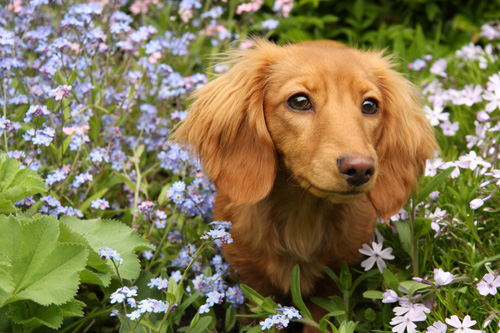Shady Secrets: Growing successful shady gardens
04 Jul 2010
Shade gardens require a little extra TLC to be successful.
Whether you’ve got tree shade, dappled shade or deep shade, here are some suggestions for growing plants in it.
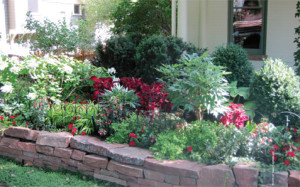 Shade gardening—nobody ever said it was easy, but why’s it so darn hard? First it’s too wet, then it’s too dry. The resulting straggly, struggling plants often wither and die.
Shade gardening is difficult, but as Nancy Kornblum of Boulder discovered, a successful shade garden just takes time and experimentation. Her persistence paid off, and Kornblum now enjoys a beautiful shade garden bursting with color that requires minimal routine maintenance.
A shade garden is its own unique environment, depending on its location. Different areas of a yard may be protected by the house from harsh winter weather, partially shielded from the sun by a fence, deeply shaded by an evergreen tree, or under the dappled canopy of an oak tree. Each of these environments presents issues to consider, including light exposure, soil structure, nutrients, moisture content and competition from other plants.
Shade gardening—nobody ever said it was easy, but why’s it so darn hard? First it’s too wet, then it’s too dry. The resulting straggly, struggling plants often wither and die.
Shade gardening is difficult, but as Nancy Kornblum of Boulder discovered, a successful shade garden just takes time and experimentation. Her persistence paid off, and Kornblum now enjoys a beautiful shade garden bursting with color that requires minimal routine maintenance.
A shade garden is its own unique environment, depending on its location. Different areas of a yard may be protected by the house from harsh winter weather, partially shielded from the sun by a fence, deeply shaded by an evergreen tree, or under the dappled canopy of an oak tree. Each of these environments presents issues to consider, including light exposure, soil structure, nutrients, moisture content and competition from other plants.
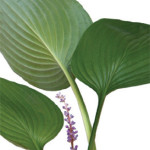 Kornblum’s yard had many challenges: “When we moved in, it was just a giant weed patch,” she says. “We tackled it one bed at a time, and it’s been a very slow process.” But after trying several different plants in different areas, she finally found what worked.
When considering a shade garden, your first step is to examine existing conditions. For example, do you have soil that drains well? Which areas are deeply shaded? Does the shade change depending on the time of year? Next, determine which plants can tolerate the existing conditions or what adjustments must be made to accommodate your plant choices.
Cultivating your shade garden will be easier and more successful if you choose plants with similar requirements, such as water needs and light requirements. Shade gardens are great places to use plants with interesting foliage or colors, like Hosta, ferns and Brunnera. Heuchera is also easy to grow and there are several varieties that can add magnificent color to your garden. For example, Heuchera ‘Silver Scrolls’ has a silvery leaf with purple veining. Heuchera ‘Chocolate Ruffles’ has chocolate-colored leaves with burgundy undersides and a thickly ruffled edge.
However, it won’t matter which plants you put in a shade garden if it doesn’t have a good foundation. When Kornblum moved into her home seven years ago, she inherited a yard with very poor soil. “It was as though someone had put a gravel pit underneath it,” she recalls. “There were so many small rocks to remove, and there was so much clay in the soil.”
Kornblum’s yard had many challenges: “When we moved in, it was just a giant weed patch,” she says. “We tackled it one bed at a time, and it’s been a very slow process.” But after trying several different plants in different areas, she finally found what worked.
When considering a shade garden, your first step is to examine existing conditions. For example, do you have soil that drains well? Which areas are deeply shaded? Does the shade change depending on the time of year? Next, determine which plants can tolerate the existing conditions or what adjustments must be made to accommodate your plant choices.
Cultivating your shade garden will be easier and more successful if you choose plants with similar requirements, such as water needs and light requirements. Shade gardens are great places to use plants with interesting foliage or colors, like Hosta, ferns and Brunnera. Heuchera is also easy to grow and there are several varieties that can add magnificent color to your garden. For example, Heuchera ‘Silver Scrolls’ has a silvery leaf with purple veining. Heuchera ‘Chocolate Ruffles’ has chocolate-colored leaves with burgundy undersides and a thickly ruffled edge.
However, it won’t matter which plants you put in a shade garden if it doesn’t have a good foundation. When Kornblum moved into her home seven years ago, she inherited a yard with very poor soil. “It was as though someone had put a gravel pit underneath it,” she recalls. “There were so many small rocks to remove, and there was so much clay in the soil.”
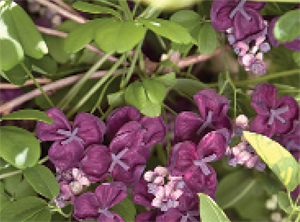 Plants need healthy soil to flourish, and healthy soil contains a balanced mix of nutrients, organic matter, air and water. While native soil can be used, performing a simple soil test is highly recommended to determine what nutrients are lacking so you can properly amend your soil. “It’s the unglamorous part about gardening,” Kornblum says, “but it’s so critical.”
Compost is a very effective way to supplement the organic material of the clay soils that are so common here. The benefits of compost are many: It increases the soil’s capacity for holding nutrients and water, it provides the small amounts of micronutrients needed by plants, and it increases soil drainage. Ultimately, Kornblum decided to install raised beds filled with rich soil she obtained from Lee Hill Peat. She adds compost to her beds every other year. “We have two compost bins in our backyard,” she says. “I’m now a master composter!”
Plants need healthy soil to flourish, and healthy soil contains a balanced mix of nutrients, organic matter, air and water. While native soil can be used, performing a simple soil test is highly recommended to determine what nutrients are lacking so you can properly amend your soil. “It’s the unglamorous part about gardening,” Kornblum says, “but it’s so critical.”
Compost is a very effective way to supplement the organic material of the clay soils that are so common here. The benefits of compost are many: It increases the soil’s capacity for holding nutrients and water, it provides the small amounts of micronutrients needed by plants, and it increases soil drainage. Ultimately, Kornblum decided to install raised beds filled with rich soil she obtained from Lee Hill Peat. She adds compost to her beds every other year. “We have two compost bins in our backyard,” she says. “I’m now a master composter!”
Plants with a Purpose
Large trees shade most of Kornblum’s yard, except for the rear, which gets a fair amount of sun. After resolving her soil issues, Kornblum’s next step was to make sure she had structure plants that worked in each area of her garden. In front, she planted Vardar Valley boxwoods and yews. On the yard’s east side she grew tall, narrow, columnar blue spruces, and tall, narrow yews in the deeper shade next to the house. Having a relatively small yard, Kornblum has taken to vertical gardening. “I’m always in search of unusual plants that grow upward,” she says. “It’s a challenge finding plants that grow up, particularly ones that thrive in the shade.”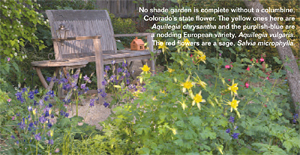 But she managed to find some stunning varieties. For instance, she planted Akebia quinata at the front of her house, where the garden is about 3 feet wide. This underused vine has very uniquely shaped purple flowers and produces amazing blue fruit. “It’s such a reliable plant, and stays green for a good part of the winter,” Kornblum says. On the east side she planted ‘Winter Gem’ boxwood, 5-foot-tall lilies and Annabelle hydrangeas—all of which make a lovely combination for this 10-foot side yard.
It’s a common misconception that flowers don’t thrive or survive in shade. Many perennials like Trollius, with its deeply cut, dark-green foliage and deep, golden-orange flowers, and Ligularia, with its arrowhead-shaped leaves and wonderful tall spikes of yellow flowers, love to bloom in shady areas. In Kornblum’s yard, the color starts with crocus and tulips, then moves on to hellebores, hydrangeas and even a sun-loving peony, which is thriving due to some sun exposure allowed by the loss of a tree limb. She also adds annual color to enhance the display she’s created. “Just because you have a shade garden doesn’t mean you can’t have color and interest throughout the season,” Kornblum says. “You just have to be patient, and willing to try different plants until you find what works for your location.”
But she managed to find some stunning varieties. For instance, she planted Akebia quinata at the front of her house, where the garden is about 3 feet wide. This underused vine has very uniquely shaped purple flowers and produces amazing blue fruit. “It’s such a reliable plant, and stays green for a good part of the winter,” Kornblum says. On the east side she planted ‘Winter Gem’ boxwood, 5-foot-tall lilies and Annabelle hydrangeas—all of which make a lovely combination for this 10-foot side yard.
It’s a common misconception that flowers don’t thrive or survive in shade. Many perennials like Trollius, with its deeply cut, dark-green foliage and deep, golden-orange flowers, and Ligularia, with its arrowhead-shaped leaves and wonderful tall spikes of yellow flowers, love to bloom in shady areas. In Kornblum’s yard, the color starts with crocus and tulips, then moves on to hellebores, hydrangeas and even a sun-loving peony, which is thriving due to some sun exposure allowed by the loss of a tree limb. She also adds annual color to enhance the display she’s created. “Just because you have a shade garden doesn’t mean you can’t have color and interest throughout the season,” Kornblum says. “You just have to be patient, and willing to try different plants until you find what works for your location.”
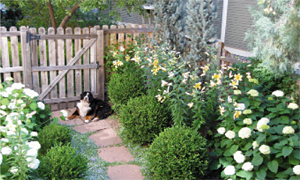 Shade gardening can be difficult, but with a little bit of research, planning and effort, you too can find a plant combination that works in your yard. Include a sitting area if you have the space, and your shade garden will become a cool retreat where you can savor your garden during hot summer days.
Shade gardening can be difficult, but with a little bit of research, planning and effort, you too can find a plant combination that works in your yard. Include a sitting area if you have the space, and your shade garden will become a cool retreat where you can savor your garden during hot summer days.


